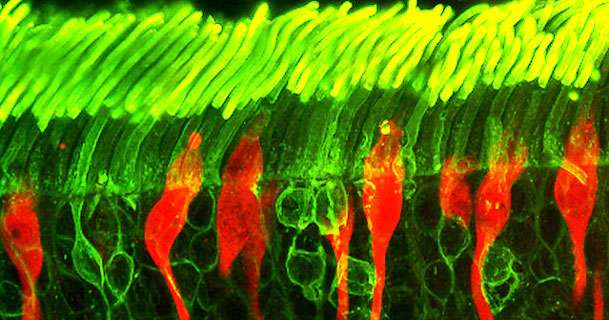Biomedical research sheds light on the mysteries of vision

One of the more studied parts of the human anatomy, the retina—the neural layer at the back of the eye that senses light—still has secrets to reveal.
"Researchers have known for decades that increased levels of light increase visual acuity," said Erika Eggers, assistant professor of biomedical engineering, physiology and neuroscience and member of the BIO5 Institute at the University of Arizona. "But we still don't understand the mechanisms behind this process. It seems like it should be relatively simple, but it's really very complicated."
Eggers has received two prestigious federal grants to shed light on the inner workings of the retina and how they affect eye disease.
Retinal Signaling and Diabetes
She is principal investigator of a $1.9 million project funded by the National Eye Institute of the National Institutes of Health, with additional support from the International Retinal Research Foundation, to study "Retinal Neuronal Signaling in Early Diabetes."
Eggers and Heddwen Brooks, UA professor of physiology and pharmacology and member of the BIO5 Institute, are taking physiological measurements from individual cells in an intact retina from a diabetic mouse model to identify signaling processes that may lead to diabetic retinopathy, the No. 1 cause of blindness in American adults.
By the time people with diabetes lose their sight, blood vessels in the retina have been seriously compromised. For many years, researchers thought vascular complications caused the blindness. But the harm may begin years or even decades earlier.
"Researchers have found that long before diabetic retinopathy sets in, neural activity in the retina is changing," Eggers said. "If we can better recognize and understand these specific neuronal processes, we may be able to develop cell-based models for drugs that slow down or even reverse the damage and prevent blindness."
Darkness Into Light
Eggers recently received a 2016 Faculty Early Career Development Award of $900,000 from the National Science Foundation, the agency's most prestigious honor for junior faculty members.
Titled "The Role of Inhibition in Light Adaptation of the OFF Retinal Pathway," the new study began on July 1 and follows related research she reported in the June 2016 issue of the Journal of Neurophysiology.
The study focuses on the process of light adaptation—the retina's ability to quickly reset cells so a person emerging from a darkened movie theater into brilliant sunlight, for example, can see clearly in short order, despite the sudden change in light intensity. Researchers know that retinal adaptation to brighter light levels is a crucial function of vision, but the process is not well understood.
Vision was once viewed as a one-way process. Light enters the eye and reaches the retina, where specialized neurons called photoreceptors convert the light into electrical signals. Photoreceptors—rods and cones—convey the signals to different types of cells, the last in the chain of retinal neurons being ganglion cells, whose axons form the optic nerve that transmits signals to the brain.
As it turns out, retinal neurons communicate in many directions and along many neural signaling pathways. The photoreceptors and other retinal neurons may be in an excitatory (on) or inhibitory (off) position, creating dynamic push-pull and feedback among neurons and neural circuits.
While it may seem counterintuitive, neurons in the off position have been shown to increase visual acuity. They help us see contrast with such precision that we can recognize a speck of dust a few yards away. Many researchers believe inhibitory activity in retinal neurons is vital for light adaptation, and Eggers seeks to discover why.
Eggers and students in the Eggers Laboratory of Retinal Neurophysiology don night-vision goggles to work in a specially built "cage," where they expose an intact, healthy mouse retina to narrow bands of light at different intensities and record electrical activity of individual neurons. From their data, they construct models to demonstrate how inhibitory signals under different light conditions alter signals reaching the ganglion cells and, ultimately, the brain.
"This research aims to understand the mechanisms of inhibitory activity in the retina and how it increases visual acuity," Eggers said. "If we succeed, it will increase our understanding of normal vision and our ability to recognize changes that portend visual disturbances and loss."




















